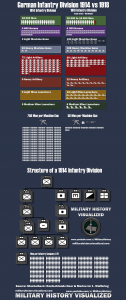Please note: This post contains amazon affiliate links. As an Amazon Associate I earn from qualifying purchases.
Infographic – German Infantry Division 1914/1918 – Organization & Structure

Intro – Basic Numbers of 1914 Division
In 1914 a German infantry division consisted of about 18000 men. The division was equipped with 4600 horses. 24 heavy Machine guns and 72 light field guns. (Source: Stachelbeck: Deutschland Heer und Marine im Ersten Weltkrieg (S. 120) – amazon.de affiliate link)
Organization of 1914 Division
Now in terms of organization and structure, a German Infantry division in 1914 consisted of 2 Infantry brigades, which themselves consisted of 2 Infantry regiments each, which consisted of themselves of 3 infantry battalions and 1 MG Company. Furthermore, the division had one artillery brigade, which consisted of 2 artillery regiments, which consisted of 2 artillery battalions each. Additionally in some cases there were also cavalry, engineer and medical units attached.
Infantry Company in 1914
This structure is quite abstract, so to get a better grasp on it in terms of men, let’s get one level lower. Each Infantry battalion consisted of 4 infantry companies. Since a division had 12 infantry battalions there was a total of 48 infantry companies. Such a company itself consisted of 150 men in peacetime, yet was increased to 270 during wartime. This meant that around 13000 (12960) of the 18000 men served in the Infantry companies.
This Layout was soon changed for various reasons. One was to get a more uniform structure, the structure of 2 subunits levels was replaced with a structure of 3 sub-units. This structure of 3 was still the determining in World War 2 infantry divisions. (Note that changing this structure didn’t necessarily lead to a change in total men or equipment, for instance the numbers of guns for a battery was changed from 6 to 4. (S. 123-124))
Changes during the War
There were many other changes throughout the war concerning the division layout, some were to deal with the change in necessities of the war and others about strategy. To note a few changes, there was the addition of a permanent medical company in 1916 and the increase engineer companies throughout the war. But probably the greatest change was in terms of equipment.
Comparison 1914 – 1918
To give you a short impression on how much an early-war Infantry Division was different from a late-war Infantry division, let’s revisit the initial numbers and compare them to a division that was intended for offensive operations in 1918, the so called “Mob-Division” or “Angriffsdivision”.
The early war division had around 18000 men, whereas the late war had 15000 to 16000 men, note that the second number is an estimate by an expert on this topic.
In terms of horses there was a decrease from 4600 to 4300, since the attack divisions received more horses than regular divisions the number of horses in overall decreased to greater extent than this display might suggest.
In terms of light machine guns there was an increase from 0 to 180.
Furthermore, the number of heavy machine guns also increased from 24 to 108.
Whereas in terms of light field guns the number of 72 was halved to 36.
Yet, there was a significant change in other artillery weapons, whereas the early war division relied solely on light field guns the 1918 division had: 12 heavy artillery guns, 18 light mine launchers and 6 medium mine launchers. Note that the mine launcher in German is called “Minenwerfer” meaning literally “mine thrower”, which is the old German name for a mortar.
(Source: Stachelbeck: Deutschland Heer und Marine im Ersten Weltkrieg (S. 120) – amazon.de affiliate link)
End Note – Visualization of the men to machine gun ratio
As you can clearly see, the number of machine guns increased substantially by more than 10 times from 24 to 288 machine guns, thus several times multiplying the amount of firepower of the division.
To illustrate in 1914 there was one machine gun for every 750 men. Whereas in 1918 there was a machine gun for every 56 men.
The number of artillery pieces in total didn’t change and stayed at 72, but the number of types was increased and thus resulted in a far more versatile artillery force. The heavy artillery provided more firepower and the mortars allowed for short range indirect fire in close coordination with the infantry, thus the overall flexibility and effectiveness of the division was increased without increasing the total number of artillery pieces itself.
Sources
Books
Stachelbeck, Christian: Deutschland Heer und Marine im Ersten Weltkrieg (amazon.com link)
| amazon.com | amazon.de |
Disclaimer amazon.com
Bernhard Kast is a participant in the Amazon Services LLC Associates Program, an affiliate advertising program designed to provide a means for sites to earn advertising fees by advertising and linking to amazon.com.
Disclaimer amazon.de
Bernhard Kast ist Teilnehmer des Partnerprogramms von Amazon Europe S.à.r.l. und Partner des Werbeprogramms, das zur Bereitstellung eines Mediums für Websites konzipiert wurde, mittels dessen durch die Platzierung von Werbeanzeigen und Links zu amazon.de Werbekostenerstattung verdient werden können.
Online Resources
Reorganization of the German Army, 1914-1918
Please note: This post contains amazon affiliate links. As an Amazon Associate I earn from qualifying purchases.

2 thoughts on “German Infantry Division 1914/18 – Visualization – Organization & Structure”
Comments are closed.